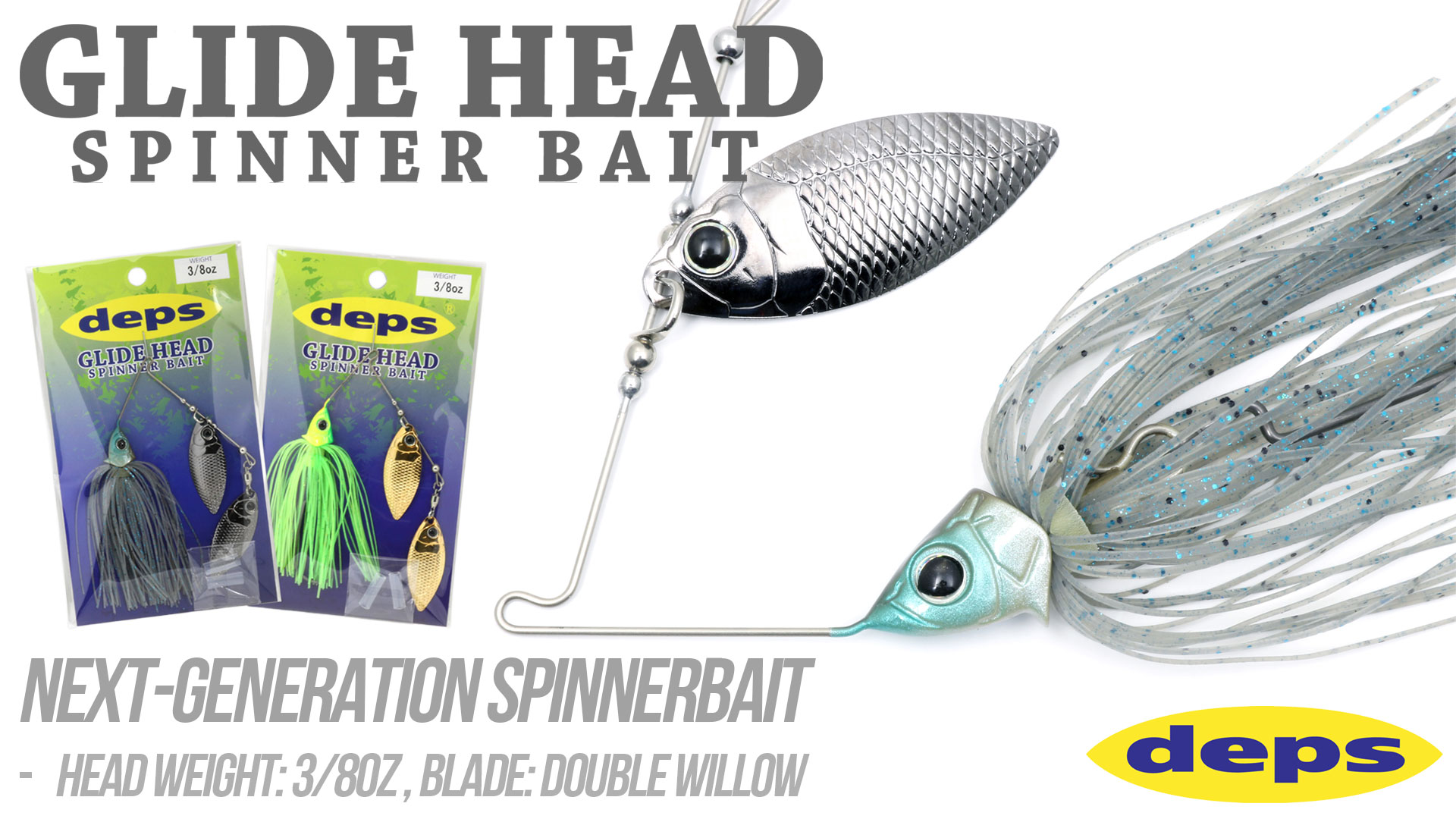You need to get the Balisong Minnow into your hands and into the water now because this is not “just another jerkbait.”
The Deps Balisong Minnow 130 SP is a new jerkbait concept. To put it in context, let us first review the overall existing jerkbait market and usage trends worldwide. Briefly, there are three common categories of jerkbait minnows used for bass:
- First, floating minnows are the least popular category, best for surface or subsurface presentations (0-2 feet deep) most often used in the summer months.
- Second, short-billed suspending (or slow-floating) jerkbaits are by far the most popular category that anglers use for bass, usually relegated to the cold half of the year (October through March). Many run 3-4 to at most 5-6 feet deep.
- Third, not nearly as popular are long-billed deep-diving suspending (or slow-floating) jerkbaits used on deeper waters, especially in winter months. Most run 6-7 to a max 10 feet deep.
- There’s also a fourth, uncommon category of sinking countdown minnows, but these are relatively rarely used by bass anglers.
Now that we have nicely summarized the worldwide jerkbait paradigm, let’s learn where the new concept Balisong 130 SP fits into that.
The line is the enabler

The concept of the Balisong 130 SP was to create something that can use with heavier line, a bigger profile jerkbait to go after big bass. Deps owner and chief designer Kazu Okumura’s concept with most every Deps lure is to raise an angler’s chances to catch monster bass specifically, and bigger-than-average bass overall. That’s the whole idea behind this larger size, larger profile jerkbait. It is designed so you can use heavier line and specifically 14-20 lb heavy fluorocarbon to get down deeper than ordinary jerkbaits.
If you watch the video here with trophy bass fishing guide Jun Maeda, what he’s doing is using heavier 14-20 lb test fluorocarbon line, making long casts, and letting the heavy line sink the lure down. Anglers in Japan that use this technique in the winter months, they’re getting the Balisong 130 SP down to 12 to 16 feet (4-5m), all because of the heavy fluorocarbon line sinking the bait down (if you let it).
Watch minute 1:20-2:50 to see how the heavy Fluro helps sink the bait. Lake Biwa Bass catches after that.
If you simply start retrieving, reeling and jerking right away, it won’t have the time necessary to sink, and the Balisong Minnow 130 SP is just going to get down to the typical suspending jerkbait’s 4 to 5 foot running depth. What anglers in Japan do differently, they’re using heavy 14-20 lb fluorocarbon, and if you let the fluoro line settle in the water column, the fluoro will let the Balisong Minnow sink down to 8, 10, 12 even 16 feet deep, depending on how long you wait to let it sink down deeper. It takes a long time to sink, but that’s what they’re doing.
Kazu Okumura’s whole idea behind the bait was to use the heavier fluorocarbon instead of adding action-deadening internal weighting or a longer diving bill to get the bait deeper. Using the heavy fluoro line as the means to get it down allows the bait to still have a high pitch rolling action at any depth from shallow to deep.
What’s in a name?

The lure action is an exaggerated high pitch rolling action, and the Japanese term for this type of action doesn’t translate well. The meaning is that it will roll back and forth like a butterfly’s wings. A butterfly’s action flutters more than anything, and that’s what the Japanese term means – the flutter. The whole idea describes the intense color flash that occurs from the lure’s high pitch fluttering, rolling action. Deps lure concept focuses on the rolling flash more than the butterfly – and that flash is where the Balisong Minnow gets its name – from the flashy balisong trick knife (aka butterfly knife) used by martial artists to demonstrate blazingly fast, flashy, non-stop knife-handling tricks and skills.
Rolling Color Flash

The lure color concepts are designed to have a lot of flash to them, just like a balisong butterfly knife. Our tendency is to think of reflective flash like metallic silver or gold, but all colors on the Balisong 130 SP are designed, patterned and painted to flash, flutter and flicker due to its high pitch rolling action.
Shattering the depth barrier
The depth barrier for most all other jerkbaits on the market today is the 7 to 10 feet depth limitation. Most short-billed jerkbaits (category two above) won’t breach 6-7 feet deep. Even with long-billed deep-diving jerkbaits (category three above), very few break 8 feet and almost none break 10 feet, which is why we call that the barrier depth beyond which few jerkbaits can go. So to be able to get the Balisong 130 SP down to 10, 12, 16 feet deep is a huge breakthrough for most anglers. Best of all, the Balisong reaches those depths without adding increased lure ballast or a longer bill which would deaden action.
How deep is deep?
At a specific elevation and water temperature, given your particular choice of heavy fluorocarbon line, you need to acquire a benchmark feel or sense for how long it will take the Balisong 130 SP to sink for you.Much depends on the heaviness and therefore sink rate of your fluorocarbon line choice, and waiting patiently while letting the line sink down below the surface.
First and foremost, making a long cast is essential, but that’s no problem because the distance achieved by the Balisong Minnow will practically empty your spool! When the lure hits the water, you need to take a moment to help the length of line break through the water surface tension by dipping the rod tip underwater and removing all the loose line and coils by recovering excess line onto the reel.
Once you help the line break through the surface tension and it starts sinking freely, then the suspending Balisong Minnow will descend along with it, following the line’s lead. When you reach that point, you can stand back and start counting it down as this is the point when you just need to wait – and the longer you wait, the deeper it will descend; so counting it down can help you to better target a specific depth.
This concept differs from a traditional slow-sinking lure having a known “rate of fall” because the Balisong Minnow itself isn’t sinking – your heavy fluoro line is sinking – and this unique suspending lure follows its lead.
Once you acquire your benchmark feel or sense for this, the technique is actually easy. Just make a long cast, and after you help the line break through the surface, count it down to your desired depth – 7 feet or 10 or 15 feet – depending on the depth of the bottom or the depth at which baitfish or bass are being marked on your electronics.
Get it in your hands now

Because the Deps Balisong Minnow 130 SP is a new jerkbait concept and technique for many readers, we won’t try to overcomplicate it for starters. We recommend you get this new concept jerkbait in your hands, master the basics of the Balisong butterfly minnow as introduced to you here and in Jun Maeda’s video, and you will enjoy success by catching deep, above-average size and trophy bass that are not catchable with traditional jerkbaits.
The uniqueness of this technique is a huge advantage for you because this is a technique that really cannot be done with many other jerkbaits – and the situations and opportunities where it can excel for you are numerous. For example, letting it sink down to be jerked through the crowns of flooded treetops is one way. Being able to catch fish cruising atop the edge of a flat, hump or rockpile, then letting it sink down to reach fish lurking below the dropoff or edge –on a single cast is the best of both worlds.
You’re really getting a single lure that straddles categories two, three and four presented at the beginning of this story – a short-billed, shallow suspending jerkbait that can go as deep as a long-billed deep-diving jerkbait, and works even deeper by counting it down – with uncompromised, unparalleled flashing, rolling action.
This powerful technique and jerkbait was never-fully-explained or publicized before in the USA, but now you know exactly what the deps Balisong 130 SP is and how to make it do things that no other jerkbait can really do for you. We trust you realize that this exciting deps lure concept and technique is the reason why you need to get the Balisong Minnow into your hands and into the water now because it is not “just another jerkbait.”





